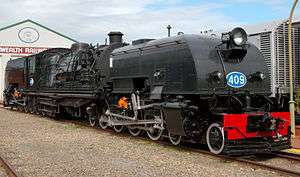South Australian Railways 400 class
South Australian Railways 400 class (1953)|

|
|
|
| Specifications |
|---|
| Configuration |
4-8-2+2-8-4 (Garratt) |
|---|
| UIC class |
(2′D1′)(2′D1′) h4t |
|---|
| Gauge |
3 ft 6 in (1,067 mm) |
|---|
| Driver dia. |
4 ft 0 in (1.219 m) |
|---|
| Length |
87 ft 5 in (26.64 m) |
|---|
| Loco weight |
148.955 long tons (151.345 t; 166.830 short tons) |
|---|
| Fuel type |
Oil |
|---|
| Fuel capacity |
6 long tons (6.1 t; 6.7 short tons) |
|---|
| Water cap |
3,700 imperial gallons (17,000 l; 4,400 US gal) |
|---|
Firebox:
• Firegrate area |
49 sq ft (4.6 m2) |
|---|
| Boiler pressure |
200 psi (1,379 kPa) |
|---|
| Heating surface |
1,970 sq ft (183 m2) |
|---|
Superheater:
|
|
|---|
| • Heating area |
390 sq ft (36 m2) |
|---|
| Cylinders |
Four, outside |
|---|
| Cylinder size |
16 in × 24 in (406 mm × 610 mm) |
|---|
|
|
|
|
|
The South Australian Railways 400 class was a class of 4-8-2+2-8-4 steam locomotives built in the early 1950s. The 400 class locomotives mainly hauled mineral trains on the South Australian Railways' narrow gauge Broken Hill line from 1953 to 1963, when they were replaced by diesel locomotives. They operated as far as far south as Port Pirie and Terowie and as far north as Quorn. The 400 class was temporarily returned to service in 1969 while the diesel locomotives were converted to 4 ft 8 1⁄2 in (1,435 mm) standard gauge. Two have been preserved, 402 at the Zig Zag Railway, Lithgow and 409 at the National Railway Museum, Port Adelaide.[1][2]
Gallery
References
Bibliography
External links
|
|---|
|
| Steam locomotives – 1,600 mm (5 ft 3 in) gauge | |
|---|
|
| Steam locomotives – 1,067 mm (3 ft 6 in) gauge | |
|---|
|
| Diesel locomotives | |
|---|
|
| Railcars | |
|---|
|
| Electric multiple units | |
|---|
|
| Passenger carriages by type |
- Sitting cars
- Dining & Buffet cars
- Parlor, Lounge & Club cars
- Sleeping cars
- Royal and Special cars
|
|---|
|
| Passenger carriages by class | |
|---|
|
| Freight vehicles by type |
- Box vans
- Flat Wagons
- Hopper wagons
- Iced vans
- Livestock
- Louvre vans
- Open wagons
- Tank wagons
|
|---|
|
| Freight vehicles by traffic |
- Ballast, Sleepers and Spoil
- Black Coal, Brown Coal & Briquettes
- Cattle
- Cement Powder
- Coiled & Slab Steel
- Corpses
- Dolomite
- Explosives
- Fertiliser
- Flour, Grain & Rice
- Gypsum
- Horses
- Lime
- Mail vans
- Bitumen, Oil & Petroleum
- Perishables
- Quarry products
- Refrigerated Goods
- Sand
- Sheep
- Soda Ash
- Timber
- Vehicles & Vehicle Parts
- Water
|
|---|
|
| Vans | |
|---|
|
| Other |
- Rail tractors
- Crane locomotives
- Miscellaneous
- Special loads
- Way and Works stock
- Staff Accommodation
|
|---|
|
| Named or significant trains | |
|---|
 Garratts, 402 leading and 401 ready to depart Jamestown for Peterborough in 1968
Garratts, 402 leading and 401 ready to depart Jamestown for Peterborough in 1968 Garratts 402 and 401 at Jamestown in the late 1960s
Garratts 402 and 401 at Jamestown in the late 1960s Media related to South Australian Railways 400 class locomotives at Wikimedia Commons
Media related to South Australian Railways 400 class locomotives at Wikimedia Commons